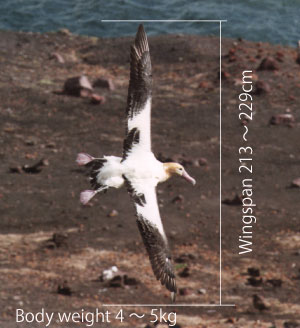- Home >
- Short-tailed Albatross >
- about Albatross
Short-tailed Albatross
- What kind of bird is it? -
Update: June 7, 2017
This page introduces the Short-tailed Albatross, an endangered species, of which the Yamashina Institute for Ornithology is carrying out conservation activities.
Short-tailed Albatross
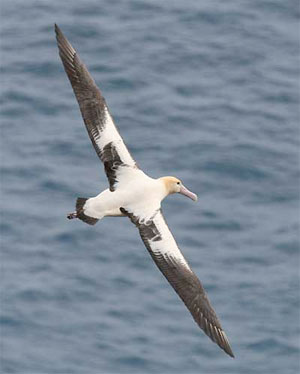
- English name: Short-tailed Albatross (Steller's Albatross)
- Japanese name: Aho-dori
- Scientific name: Phoebastria albatrus (Diomedea albatrus)
- Order Procellariiformes Family Diomedeidae
- Special Natural Treasure* (Specified under the Law for the Protection of Cultural Properties. Torishima Island, the main breeding area of the Short-tailed Albatross, is also designated as a natural treasure (natural conservation area) )
- Endangered Species of Wild Fauna and Flora (specified by the Law for the Conservation of Endangered Species of Wild Fauna and Flora)
- VU (vulnerable species)(Ministry of the Environment, Japan (2014) Threatened Wildlife of Japan. 4th. Ed.)
- VU (IUCN Red List of Threatened Species 2016)
Relatives of the Short-tailed Albatross
The Short-tailed Albatross belongs to the family Diomedeidae of the order Procellariiformes. Procellariiformes consist of Diomedeidae (albatrosses), Procellariidae (shearwaters and gadfly petrels), Hydrobatidae (storm petrels), and Pelecanoididae (diving petrels). They are all genuine seabirds that spend all of their lifetime out on the sea except when they return to land to breed. The albatross family, Diomedeidae, is comprised of 22 species, out of which 18 occur in the southern hemisphere, one near the equator and three in the northern hemisphere. The Short-tailed Albatross, one of the northern hemisphere species, is the target for conservation and research activities at the Yamashina Institute. The two other species found in the northern hemisphere are Black-footed Albatross and Laysan Albatross, both smaller bodied than Short-tailed Albatross, and can also be observed within Japan.
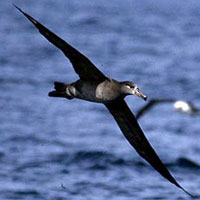
Black-footed Albatross (Diomedeidae)
(Photo: Kazuyasu Kisaichi)
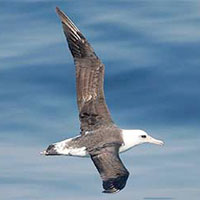
Laysan Albatross (Diomedeidae)
(Photo: Kazuyasu Kisaichi)
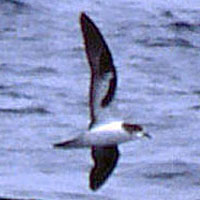
Bonin Petrel (Procellariidae)
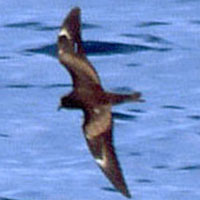
Matsudaira's storm petrel (Hydrobatidae)
Relatives of the Short-tailed Albatross
It is also being proposed by some researchers that the three northern hemisphere species and the one equatorial species be separated from the genus Diomedea and be grouped as an independent genus Phoebastria due to their phylogenetic relationships. In this case, the scientific name of the Short-tailed Albatross will change from the current Diomedea albatrus to Phoebastria albatrus.
Where do Short-tailed Albatrosses live, and in what numbers?
About 150 years ago, the Short-tailed Albatross population, estimated to be in the order of hundreds of thousands, were distributed over several islands in the northern Pacific. Nowadays, they are colonized only in Torishima in the Izu, and in the Minami-kojima and Kita-kojima of the Senkaku Islands. Dr. Hiroshi Hasegawa of Toho University estimates their current Torishima population to be about 4,200. The total population in the Senkaku Islands is estimated to be 300 to 350 individuals, thus most of the world's Short-tailed Albatross population occur in Torishima (Hasegawa, 2006). The rapid decline in the Short-tailed Albatross population was caused by the over-hunting for feather harvesting during the second half of the 19th century and the first half of the 20th century.
How and where do they live?
Short-tailed Albatrosses spend all summer on the sea, resting on the sea surface or flying over the sea. The recent satellite tracking studies have revealed that they leave the breeding island during the summer and move north towards the Aleutian Islands. Some individuals further travel to the sea off Alaska, Canada and California. The adults return to the nesting site in the autumn and breed in winter, but young birds under about 5 years old do not return to the island and stay on the sea all year round, eating fish, squids, krills, etc.
Breeding colonially on an isolated island
Short-tailed Albatrosses breed colonially on isolated islands. Isolated islands surrounded by sea provide limited space for breeding, but protect Short-tailed Albatrosses from land mammals and other terrestrial predators, and thus is a safe place for laying eggs and raising chicks. Breeding colonially on these islands do not pose any inconvenience as long as enough food can be obtained. Some bird species build their nests in woodlands or grasslands. In most cases these nests are spaced out and are built hidden so that they are not so visible by others. Such nesting arrangement is advantageous for these birds because it makes it easier to obtain food, and that there is ample amount of space suited for building nests in woodlands and grasslands. Furthermore, they build their nests spaced out and hidden in order to protect themselves from predators. These birds that live in woodlands or grasslands and Short-tailed Albatrosses that breed on isolated islands show a marked contrast in their ways of living. Many seabirds other than the Short-tailed Albatross also breed colonially on isolated islands surrounded by the sea.
Live a long life, lay only few eggs and nurture them with care
The Short-tailed Albatross live a long life. Hasegawa has reported on an individual that was raising a chick at the age of 31 (Hasegawa, 2006). A longevity record of the Laysan Albatross is 66 years (U.S. FWS, 2017), which suggests a possibility that the Short-tailed Albatross live as long.
The Short-tailed Albatross begins breeding relatively late, earliest at the age of 5 years and 7 years on average. It takes about 8 to 10 years for them to attain their beautiful full adult dress. They lay only one egg per year with the incubation period of 64 to 65 days. It takes about 4.5 months for a chick to fledge. Some bird species raise multiple chicks at once and breed several times a year but live a much shorter life. In contrast to these species the Short-tailed Albatross have a low birth rate but also a low death rate. They have their life designed as to live a long life and carefully raise only few children on an isolated island free from predators. However, this strategy only works if there are no predators around, in other word they can easily get decimated if unexpected predators appear. The way of living of the Short-tailed Albatross is strongly linked to the fact that it was so easy for humans to cull millions of albatrosses, and albatrosses could not recover their population after their population decreased.

Chicks 3 months after hatching
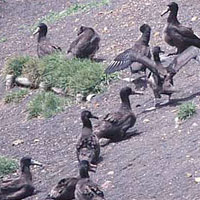
Chicks immediately before fledging
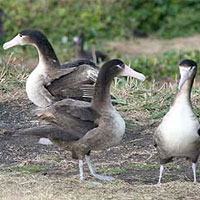
Young bird when returned to Torishima
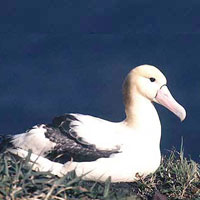
Beautiful adult bird
A year of a Short-tailed Albatross
The Short-tailed Albatross spends the summer in the north Pacific and return to their breeding island in winter. Their typical yearly events are as shown below;
- 10-15 October:
Arrive on the island - End of October to beginning of November:
Lay one egg per pair. Both sexes take turns to incubate for about 10 to 20 days and maximum 25 days each. - End of December to Beginning of January:
Eggs hatch after about 65 days. Both sexes take turns to brood the chick at the beginning. - Late April:
Parents fly away to the sea and leave chicks behind on the island. Chicks at this time weigh more than the parents. - Mid to late May:
After a few weeks of fasting chicks fledge to the sea
Chicks are fed with squids, krills, fish, etc caught and regurgitated by the parents. After the parents leave the breeding island, the chicks left behind spend a few weeks without parents' care before they fledge. This way of fledging is typical for the Procellariiform species.

